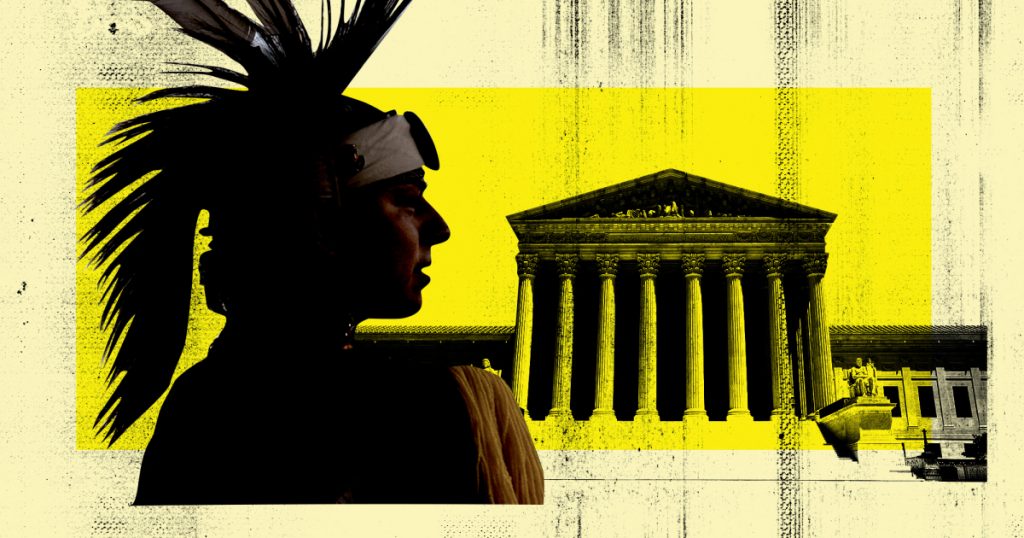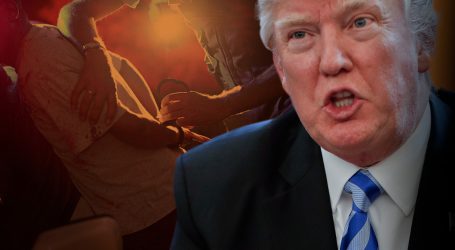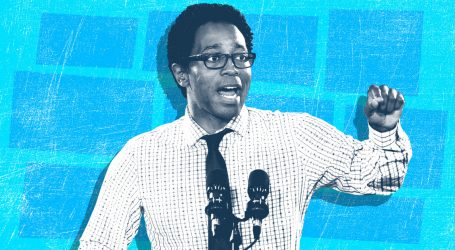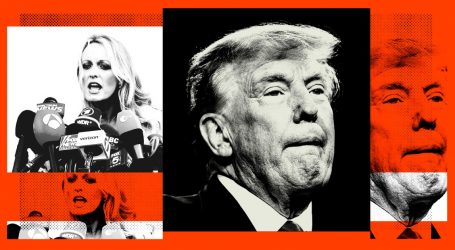How Native Tribes Started Winning at the Supreme Court
Mother Jones illustration; Michael S. Williamson/The Washington Post/Getty, Liu Jie/Xinhua/Getty
For indispensable reporting on the coronavirus crisis and more, subscribe to Mother Jones’ newsletters.On a September morning in 2001, Native American leaders from across the country convened in a ballroom at the Grand Hyatt in Washington, DC, to talk strategy. The Supreme Court was escalating a destructive war on tribal sovereignty, weakening the power of Indigenous nations to protect their people and lands. As the meeting opened, Sen. Daniel Inouye of Hawaii took the podium and stunned everyone with the news that two planes had just hit the twin towers of the World Trade Center. The meeting’s 300 attendees flocked to the lobby to watch live coverage of the attacks.
Less than one hour later, some esteemed tribal leaders called for the meeting to continue as planned. “What’s happened is awful,” lawyer Riyaz Kanji recalls them saying. “But we came here from all around the country to address some big issues. So let’s get to work.”
Their willingness to proceed testified to the urgency of their task. Though federal policies were slowly becoming more supportive of Native peoples, the Supreme Court had delivered two decades’ worth of judgments limiting their progress. In 2002, legal scholar David Getches “found that convicted criminals won 34 percent of the time while Indian tribes have won only 23 percent of the time.” He added, “Nobody does worse in this Supreme Court than Indian tribes.” After 2000 brought particularly brutal rulings over taxation and jurisdiction issues, tribal leaders and lawyers decided they needed a new approach. Thus, on September 11, 2001, they formed the Tribal Supreme Court Project—and their luck began to change.
The project was instrumental in securing last month’s victory in one of the most important tribal cases of the past century. In McGirt v. Oklahoma, the Supreme Court found that nearly half of Oklahoma still belongs to the Muscogee (Creek) Nation and other tribes, at least for jurisdictional purposes. In a majority opinion that evoked strong emotions throughout Indian Country, Justice Neil Gorsuch—a Trump appointee—suggested that the court has a duty to hold the US government to its oft-broken promises to tribes, marking the fourth consecutive ruling in favor of Natives’ treaty rights. This may be the dawn of a new judicial era, catalyzed by the Tribal Supreme Court Project and by new justices whose opinions reflect an evolving understanding of Indian law and history.
Federal courts play a much larger role in the lives of Native Americans than most people’s, says Elizabeth Kronk Warner, citizen of the Sault Ste. Marie Tribe of Chippewa Indians and dean of the law school at University of Utah. That’s because “Indian” is technically not a racial identity but rather a legal designation. “It’s by virtue of my political relationship with my tribe that I also have a special relationship with the federal government,” she says. For tribal members, “everyday issues” like hunting rights and land ownership “become questions of federal law,” specifically a long-neglected branch of it called “Indian law.”
Under Indian law, crimes committed by Indians on reservations must be tried in federal court if they are felonies or involve non-Indian victims. This was at issue in McGirt v. Oklahoma: A Seminole man named Jimcy McGirt was sentenced to life by the state of Oklahoma for committing sex crimes against a child in 1996. Yet the felony happened on lands that Congress designated as the Muscogee (Creek) reservation after having removed the Muscogee from their southeastern homelands during the “Trail of Tears” in the 1830s.
Later, after encouraging white settlers to purchase much of the land promised to the Muscogee and four other tribes, both Congress and the state of Oklahoma ceased to recognize the original reservation boundaries. Yet the Supreme Court held last month that Congress never officially disestablished any of the five reservations, meaning those lands—making up more than half the state—are still part of “Indian Country,” a patchwork of Native communities across the US where state laws rarely apply. Jimcy McGirt, and dozens of tribal citizens in similar situations, should have been tried in federal court.
They may now be retried, thanks to the efforts of McGirt’s lawyer Ian Gershengorn, Riyaz Kanji (who argued on behalf of the Muscogee), and others connected to the Tribal Supreme Court Project, a nationwide brain trust of more than 300 attorneys and scholars who collaborate to boost tribes’ arguments before the Supreme Court. It was formed out of a sense that the highest court in the land, a sometime ally of tribes throughout history, was turning sour on tribal sovereignty. John Echo-Hawk, founder of the Native American Rights Fund (NARF), was echoing a common sentiment when he declared in 2001, “There’s a crisis in Indian Country, and it’s called the US Supreme Court.”
Since then, the Tribal Supreme Court Project has monitored 400 Indian law cases as they made their way through the courts, watching those likely to reach the Supreme Court and inviting their network to collaborate on petitions, arguments, and representation for the more than 150 that have. Spreadsheets are updated and shared by Joel West Williams, a Cherokee attorney who leads the initiative for NARF, which along with the National Congress of American Indians has anchored the Tribal Supreme Court Project from the start. In that time, says Williams, “the quality of tribal advocacy at the court has substantially improved,” not just with regard to representation but “the whole package of court presentation.”
Within two days of the Supreme Court agreeing to review the McGirt case, Williams was on a call with Kanji to plan a strategy around amicus briefs, the written arguments filed by outside parties interested in a case. Kanji knew from his time clerking for David Souter, in 1994, that Supreme Court justices have neither the obligation nor the time to read every brief that’s filed. He suggested the project focus on coordinating a limited lineup of briefs that clarify key issues, written by people of interest to the court (rather than piling on the briefs ad hoc over time). For McGirt, they recruited former US attorneys to file briefs challenging Oklahoma’s argument that redrawing the jurisdictional lines would create legal turmoil, and they found state elected officials to write about the high degree of existing cooperation between Oklahoma and tribes.
Williams invited everyone on the project’s email list to a call, soliciting feedback from anyone interested—which, given McGirt’s potential implications for all tribes, was an extra large group. “The project has become a clearinghouse for information,” says Kanji, an immigrant from Uganda who has devoted hundreds of pro bono hours to the project. When the lead attorneys needed more evidence of the US “crushing tribal reservations,” they quickly accumulated examples from across the country. “It’s a very inclusive approach,” says Williams.
The Tribal Supreme Court Project was inspired by a similar initiative by the National Association of Attorneys General, which began coordinating efforts to defend states before the court in 1982, as Reagan’s “New Federalism” devolved regulatory powers to states and exposed them to more litigation. Yet despite the groundbreaking intertribal collaboration, the Indigenous project has only begun to win consistently in the past five years, since the arrival of Justices Sonia Sotomayor, Elena Kagan, and Gorsuch. Before that, the court had already flip-flopped several times in its approach to tribal issues.
Indian law as we know it dates back to the 1820s, when then–Chief Justice John Marshall authored the first of three landmark Supreme Court decisions known as the “Marshall Trilogy.” These rulings, two of which involved the Cherokee Nation in the lead-up to the Trail of Tears, established the federal government’s primacy over states in dealing with Indigenous nations, who Marshall said had a sovereign right to manage their own affairs.
Their newly recognized sovereignty was soon crushed when President Andrew Jackson pushed forward with a program of forced removal, kicking off a century in which Indian policy shifted toward conquest, land grabs, and annihilation. The Supreme Court began following Congress’ and the executive’s lead, says Dylan Hedden-Nicely, a citizen of Cherokee Nation and law professor at the University of Idaho. The turning point was United States v. Kagama, which in 1886 held that the federal government could prosecute major crimes committed by one Indian against another, diminishing tribes’ sovereign right to govern their own citizens.
The Supreme Court’s last swing in favor of tribes came during the civil rights movement of the 1960s—the era of the American Indian Movement and the Alcatraz occupation (pictured above).AP photo“Indian tribes are the wards of the nation,” wrote Justice Samuel Miller in that majority opinion, which Hedden-Nicely says “acknowledged the sovereignty framework laid out by John Marshall, but at the same time essentially said, ‘It doesn’t apply anymore.’”
From that point on, Hedden-Nicely argues, the court had two conflicting sets of precedents it could follow. In deciding a case, it would choose one or the other to justify its desired outcome—generally, the one least detrimental to non-Indians. “Rather than using baseline rules and applying them without bias, the court has been weighing tribes’ rights against how they would affect the lives of non-Native people,” he says.
This created a “whipsaw effect”: As successive waves of federal officials tried to weaken tribes, then build them up, then “terminate” their special status, the court followed, hewing back and forth. The legal standing of tribes was always shifting, inhibiting their economic development.
Prior to this past decade, the court’s last swing in favor of tribes came during the civil rights movement of the 1960s, when the American Indian Movement and Alcatraz occupation won federal self-determination policies that gave tribes increasing control over federal lands, funds, and programs. Justice Thurgood Marshall took special interest in Indian law and wrote opinions attempting to fortify it. In Santa Clara Pueblo v. Martinez, his majority opinion advanced the idea that tribes, who pre-date the US Constitution, were not bound by all its limitations on statutory power. In the landmark Oliphant case, he argued in his dissent that tribes should be able to prosecute non-Indians on their reservations as a matter of tribal sovereignty.
With the Indian Regulatory Gambling Act of 1988, money began rolling into tribes that could be spent on more and better lawyers. This was good timing. Under new Chief Justice William Rehnquist, the court was adopting a “colorblind justice” approach to questions of tribal rights, chipping away at Native sovereignty.
Which brings us to 2000, when the project arose after two devastating decisions. One barred tribes from taxing non-Indian businesses on their reservations; the other limited their jurisdiction over Indian lands held in federal trust. In both unanimous rulings, Justices Ruth Bader Ginsberg and Sandra Day O’Connor joined Rehnquist, Clarence Thomas, and Antonin Scalia. Positions on Indian law, still largely opaque even to Supreme Court justices, rarely follow neat ideological lines.
Tribal advocates are not surprised that Gorsuch, a conservative Trump appointee, has consistently favored tribes. Previously appointed by President George W. Bush to the 10th Circuit Court of Appeals, which covers Colorado, Kansas, New Mexico, Oklahoma, Utah, and Wyoming, Gorsuch adjudicated many tribal cases and developed an understanding of Indian law commended by Native leaders. Like fellow Westerner Sandra Day O’Connor, Gorsuch met and dialogued with tribal lawyers outside the courtroom. While his “textualist” approach might be reactionary on reproductive freedoms or gun laws, Indian law scholars say it provides a strong basis for upholding the rights and reservations promised to tribes in treaties.
“We’ll be quoting passages in [Gorsuch’s McGirt] opinion for the rest of our lives,” Kanji says. In his ruling, Gorsuch argues that the court shouldn’t ratify “the rule of the strong” over “the rule of law”: Treaty promises can’t be nullified through conflicts or swindles but only by explicit acts of Congress. Similar principles were affirmed in last year’s decision interpreting the Yakama Nation Treaty of 1855 as exempting its reservation from a fuel tax, and another that supported the Crow Tribe’s right to hunt on federal lands.
In 2018, Washington v. United States upheld a lower court decision requiring the state of Washington to spend billions redesigning roadways to support salmon spawning, in order to preserve Indigenous fishing rights. Says Kanji, who helped argue that case, “The idea that tribes can use their treaty rights as a sword to protect the environment has gained greater currency,” especially since the tribes united at Standing Rock in 2016 launched litigation against the Dakota Access pipeline.
A district court judge recently ordered the pipeline to shut down, just one example of how growing respect for tribal sovereignty is also yielding victories in the lower courts. “The Supreme Court definitely sets that tone,” says Kanji. “Its decisions are binding precedent.” But he also acknowledges that the lower courts are diverse: Some appeals judges have construed tribal rights even more narrowly than Rehnquist, while others steadily expand them. Kronk Warner and Hedden-Nicely agree that a positive trend is emerging. As social movements like Standing Rock and Black Lives Matter raise the profile of oppressed groups and their struggles, law schools are finally teaching Indian law, and the new generation of lawyers and judges has been primed to hear it. “It snowballs from there,” says Hedden-Nicely. Those who understand the basis of tribal sovereignty are usually more inclined to defend it.
Today’s reckoning with American history might also play a role. Gorsuch opens his opinion by narrating a surprisingly emotive picture of tribes being marched halfway across the country, only for their new lands to be stripped—in previous eras such pathos may not have carried much weight. Kanji says his side strategically appealed to history. “The states or others will spin these stories about how tribal rights were abrogated over time,” he says. “Unless you’re offering a narrative that’s more historically faithful, your side of the story will be lost.”
While the Supreme Court is insulated from outside advocacy, grassroots movements can beget changes that eventually affect major rulings. Justices “reflect what the political system looked like when they were appointed, which is driven by what our culture is like,” says Hedden-Nicely. “But there’s always a lag,” since judicial turnover is slow; lawmakers and executives only gradually get chances to appoint and confirm new judges. Thus Kanji believes tribes must fight for their rights both in the courtroom and in the arena of public opinion. “Many tribal cases fall at the intersection of the courts and the political system,” he says. “You can’t litigate these cases in a vacuum, because there’s always the possibility that a judicial gain could be undone by a legislative correction.”
The Tribal Supreme Court Project is already working on a Firth Circuit case concerning the Indian Child Welfare Act, which Hedden-Nicely calls “the single most important issue for Indian Country today.” Brackeen v. Bernhardt asks whether ICWA, through which Congress granted tribes priority in deciding foster care placements for Native children, violates an alleged Constitutional restriction on “racial preferences.” A judge ruled in 2018 that overturning the law would violate tribal sovereignty. Hedden-Nicely thinks the case isn’t really about children but is just one of many “unrelenting attacks on the idea that Indians have any special status under the law.”
He doesn’t expect the Supreme Court, which has already twice upheld ICWA, to hear the Brackeen case. And if it did, given recent trends, it’d be unlikely to decide against tribes.
“At a time where Congress is not being particularly helpful on Indian policy, and the executive is being actively antagonistic, it’s very comforting to have at least one branch of government acting in a way that’s consistent with their trust responsibility to Indian tribes,” says Hedden-Nicely. When the court sides with Congress and the president in ignoring tribal sovereignty, “bad things start to happen.”





